Find out about Source Heat Pumps and the options open to you for heating your property.
Heat Pumps
A Heat Pump uses the same technology as your domestic fridge, in fact, a fridge is a type of heat pump. If you look behind your fridge you will notice the back of the fridge feels warm, this heat is a by-product of the refrigeration process. A heat pump used for generating thermal energy to heat a building basically uses this heat rather than wasting it like a fridge. In terms of a domestic fridge, the fridge compartment would be the energy source, equivalent to the air or ground, and the heat at the back of the fridge would be your heating system. A heat pump takes a low-grade temperature source and compresses it, which achieves the temperature required for heating our properties.
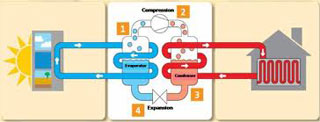
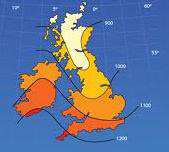
The most abundant source of energy available to us is the sun. On average in Europe we receive 1000 KW Hours per m2 per annum as irradiated energy from the sun, equivalent to approximately 100m3 of Natural gas or 100 litres of oil. Heat pumps use the natural environment as the energy source for generating heat. The three main sources available for heat pumps are the ground, the air and water.
Air Source Heat Pumps
An ASHP relies on the ambient air temperature to provide the energy we need for our properties. The ambient air temperature is an ever changing source of natural energy as the air temperature changes throughout the year being at its coldest when the heat pump is most required in the winter. The air temperature has an impact on the electrical consumption of a heat pump as it uses less energy in milder weather due to the fact that the air temperature is nearer to the heat output temperature generated for heating compared to mid-winter.
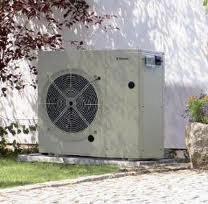
ASHP’s can work in air temperatures as low as -20 degrees ASHP’s do not require the cost and disruption of excavating land or bore hole drilling works associated with ground source heat pumps; therefore they are often the favoured unit, especially when considering retro fit installations offering the most economical installation.
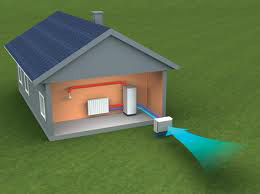
Ground Source Heat Pumps
Horizontal ground loops
Horizontal ground loops require a large area of excavation to a depth of approximately 1.5m below ground level for installing ground loops. The size of excavation will depend on the size of the property being heated and the size of the heat pump.
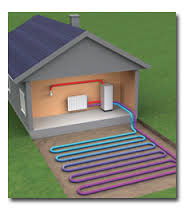
Bore Hole ground Loops
A bore hole installation will require drilling a bore hole to a depth of between 50-150m into the ground and lowering two pipes connected with a U bend at the bottom all the way down to the bottom of the bore hole. These pipes are piped back to the heat pump. The depth and number of bore holes will depend on the size of the property and the size of the heat pump.

Ground Source Heat Pump
Ground source heat pumps (GSHP) A GSHP extracts its heat from the ground which has absorbed its energy from the sun. Unlike ambient air temperature the ground temperature remains reasonably consistent throughout the year, typically at 8-12 degrees depending on how deep you go into the ground. The deeper you go the less the seasonal ambient temperature will affect the ground temperature. Due to the consistent temperature of the ground, a GSHP’s electrical consumption remains reasonably consistent and easy to predict. Unlike an ASHP a GSHP is generally installed within the property with pipe lines extending from the unit to the ground, these are called ground loops and contain an anti-freeze water solution called brine.
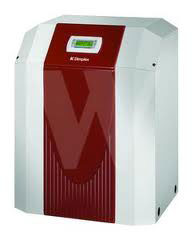
Ground Source & Air Source Heat Pumps – Overview
A heat pumps size will depend on the size and thermal efficiency of the property being heated. A SAP calculation will need to be carried out to ascertain the heat load required for the building.
A heat pump is designed to generate temperatures up to 55 degrees. Due to this temperature heat pumps are generally better suited to new build properties which are built with high insulation levels.
Heat pumps are also suited to retrofit installations. If retrofitting a heat pump to an existing properties heating system there will possibly be some incidental works to be considered at the design stage. These could be improving the thermal efficiency of the fabric of the building and replacing existing radiators with larger more efficient types due to low flow temperatures.
Underfloor heating is a preferred heat emitter when combining with a heat pump as underfloor heating requires lower flow temperatures than a radiator due to underfloor heating covering a large surface area.
In most circumstances, a heat pump system will be designed to deliver full heating and hot water demand. In circumstances where the heat pump can’t achieve the full heating load all year round then a backup heat source will need to be factored into the system design like an immersion heater or boiler.
Solar thermal systems and photovoltaic solar panels are a good option to consider when choosing to install a heat pump. A solar thermal system would cover the hot water demand in the summer time allowing the heat pump to be turned off and only used as a backup. Photovoltaic panels would generate electricity to support heat pump electrical consumption.
Contact Us
To get a FREE no-obligation quote, call Tel: 01202 386439 or Mobile: 07887 647921 now or complete our online enquiry form.
